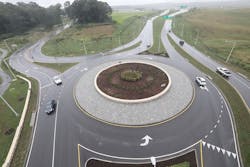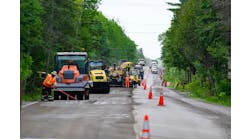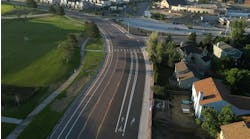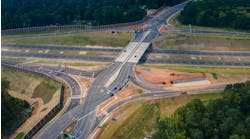This project first appeared in these pages back in July, and since then the final buttoning up has just about been completed.
Though this project opened to traffic back in November of 2018, it required a significantly larger amount of post-construction care than other projects of comparable size. A major reason for that is its proximity to the campus of Virginia Polytechnic Institute and State University, commonly known as Virginia Tech. The school had not only ceded a portion of the right-of-way for the project to the Virginia DOT in order to make the work happen, but it also has a vested stake in the aesthetic quality of the project site, and that stake includes more than just the road itself.
“Virginia Tech has special events year-round—football games, homecoming, student move-in and -out, and so forth,” VDOT Senior Roadway Design Engineer Phil Hammack, P.E., told Roads & Bridges. “The main campus is only about a half-mile away, and the interchange is situated right at entrance to campus. So even though we opened to traffic last year, we took another year to complete the landscaping and ensure an establishment period for the trees [we planted] to make sure they took and were healthy. This is the main gateway to campus.”
This particular spot on Route 460 had previously sported the only signalized intersection in a more than 37-mile stretch, and as one might imagine on a high-volume, high-speed corridor, there were rear-end collisions aplenty.
Twin structures were erected over Route 460 as part of the interchange. In the process, design concessions were made to future corridor expansion.
“We were going from an at-grade intersection to a grade-separated interchange,” VDOT Traffic Engineer Anne Booker told Roads & Bridges. “We looked at several options, and what really drew us to the DDI was the ability to handle the peak flows of traffic in a way that was land-use efficient. We did not want to take excessive space for this interchange if we could build something smaller and just as efficient. Fifty percent of the crashes at the intersection were rear-end crashes. People would get lulled into not expecting a signal, or would travel at high rates of speed, which made it harder to stop. We had a lot of warning devices out there, but the crash history was still significant.”
The $46.7 million replacement of that signalized intersection with a diverging diamond interchange (DDI) has served as a boon both to Virginia Tech and to the plethora of businesses in the immediate area, as well as the citizens of the town of Blacksburg. Anther project goal was to accommodate planned runway expansion at the nearby airport by relocating Research Center Drive and realigning Huckleberry Trail, a mixed-use trail that provides an alternative means of travel between Blacksburg, Christiansburg, and Montgomery County.
The goal of connecting Route 460 to Southgate has brought about both capacity improvement and an ease in traffic congestion. The relocated Southgate Drive replaces the former two-lane facility with a four-lane, median-divided roadway with new roundabouts at Research Center Drive and Duck Pond Drive. The project also included the reconstruction and addition of 2.6 miles of shared-use path, some of which was comprised of Huckleberry Trail; the winding foot and bike path skirts the project site in several places and runs, at one point, beneath 460 itself.
Project designers were careful to build for today’s needs, while laying the groundwork for future growth.
These structures serve as a sort of gateway to Virginia Tech, which ceded some of the right-of-way in order to make this project happen.
“We went from two lanes to four (12-ft), two in each direction, with curbing along the roadway,” Hammack said. “If we need to add additional lanes later on, we devised a way to do so on the interior of the twin concrete beam bridges that were erected over 460. The exterior features the Virginia Tech name and aesthetic designs, so those can be preserved.”
Virginia Tech also required project designers to maintain and enhance the campus viewshed, which includes historic Smithfield Plantation and Preston Cemetery. Wooded areas with more than 250 trees that each exceed 300 years of age were likewise meticulously surveyed and integrated into the design to limit impacts. Along with the university’s interests, an extensive amount of coordination was required to accommodate the airport’s expansion. VDOT entered into an agreement with the airport to combine the design and construction of road and trail elements needed for the runway extension into the Southgate project.
All told the scope of the project impacted 2 miles of mainline Route 460; a further 3.4 miles of surface roads and ramps; and 2.6 miles of shared-use pathway. Now that all is said and done, and the fall semester is in full session, Virginia Tech has a reborn marquee gateway access point and the city of Blacksburg has a keystone piece of infrastructure that is future-minded.



